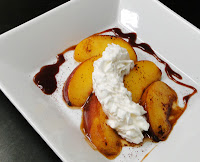Getting up at 5:30 am for the Culinary Fundamentals class has reprogrammed my biological clock. The positive side is that I'm seeing a lot of beautiful sunrises! My daughter, who loves potato gnocchi, will be happy to know that I learned the secret for making them light and fluffy. My problem has been that I've followed recipes slavishly and missed the secret that it is not the recipe but the technique that is important. Like fresh pasta dough, gnocchi dough should be mixed with the minimum amount of flour to keep them light.
In class, we made gnocchi with garlic and chili--I made mine with goat cheese, browned butter and sage to pair with a nice Pinot Noir--the Torii Mor, La Colina Vineyard from the Dundee Hills of Oregon. Goat cheese and Pinot is a terrific pairing.
In class, we made gnocchi with garlic and chili--I made mine with goat cheese, browned butter and sage to pair with a nice Pinot Noir--the Torii Mor, La Colina Vineyard from the Dundee Hills of Oregon. Goat cheese and Pinot is a terrific pairing.
Homemade Gnocchi With Goat Cheese and Brown Butter Sauce:
2 large russet potatoes
2 egg yolks
4 oz. room temperature goat cheese
All-purpose flour, about a cup
4 Tbsp. butter
2 Tbsp. finely minced sage
2 Tbsp. finely minced parsley
4 Tbsp., approximately, of grated Parmesan
Salt and fresh ground black pepper
Pierce the potatoes with the tines of a fork to release steam when they cook. Bake the potatoes in a 350 degree oven until done--turn once during the approximate 1 hour baking time. Remove and let cool a bit. In the meantime, mix the egg yolks and goat cheese. Grate the potatoes onto a tray or into a large bowl. Add the egg/cheese mixture and a half cup of flour. Mix them together with your fingers and gather into a soft dough, adding flour as needed. Add the least amount of flour possible so the dough stays light. As the dough starts to come together, press it gently into a four balls. On a lightly floured board--again using as little flour as possible--roll out each ball into a coil of dough, gently pressing out any air pockets. Cut into 1/2" pieces. For use with sauces like marinara, one would press the dough with the back of a fork to make grooves in one side to hold the sauce. With a butter sauce, there is no need to add the grooves as the butter will easily coat the gnocchi. Serves 4.
 Tips on Technique from Chef Fredericks:
Tips on Technique from Chef Fredericks:
1. Cut the end of the potatoes at an angle--this part will go on the grater first.
 2. Use the skin of the potato to protect your hands from the hot interior. The hot grated potato will let off steam, so a tray is good for spreading the potato out to prevent the gnocchi from being sodden.
2. Use the skin of the potato to protect your hands from the hot interior. The hot grated potato will let off steam, so a tray is good for spreading the potato out to prevent the gnocchi from being sodden.
3. Press the dough gently into coils--there will be some air pockets that you want to get rid off. Cut the coils into manageable lengths when rolling. See video of Chef Fredericks forming and rolling coils.
4. See video of Chef Fredericks to see how to make grooves on one side of the gnocchi with a fork.
2 large russet potatoes
2 egg yolks
4 oz. room temperature goat cheese
All-purpose flour, about a cup
4 Tbsp. butter
2 Tbsp. finely minced sage
2 Tbsp. finely minced parsley
4 Tbsp., approximately, of grated Parmesan
Salt and fresh ground black pepper
Pierce the potatoes with the tines of a fork to release steam when they cook. Bake the potatoes in a 350 degree oven until done--turn once during the approximate 1 hour baking time. Remove and let cool a bit. In the meantime, mix the egg yolks and goat cheese. Grate the potatoes onto a tray or into a large bowl. Add the egg/cheese mixture and a half cup of flour. Mix them together with your fingers and gather into a soft dough, adding flour as needed. Add the least amount of flour possible so the dough stays light. As the dough starts to come together, press it gently into a four balls. On a lightly floured board--again using as little flour as possible--roll out each ball into a coil of dough, gently pressing out any air pockets. Cut into 1/2" pieces. For use with sauces like marinara, one would press the dough with the back of a fork to make grooves in one side to hold the sauce. With a butter sauce, there is no need to add the grooves as the butter will easily coat the gnocchi. Serves 4.
 Tips on Technique from Chef Fredericks:
Tips on Technique from Chef Fredericks:1. Cut the end of the potatoes at an angle--this part will go on the grater first.
 2. Use the skin of the potato to protect your hands from the hot interior. The hot grated potato will let off steam, so a tray is good for spreading the potato out to prevent the gnocchi from being sodden.
2. Use the skin of the potato to protect your hands from the hot interior. The hot grated potato will let off steam, so a tray is good for spreading the potato out to prevent the gnocchi from being sodden. | |||
| Wine Themed Crossword by Tama | |||
Try your hand at my second attempt at creating a wine themed crossword!
 | |||
| Wine Themed Crossword by Tama | |||













